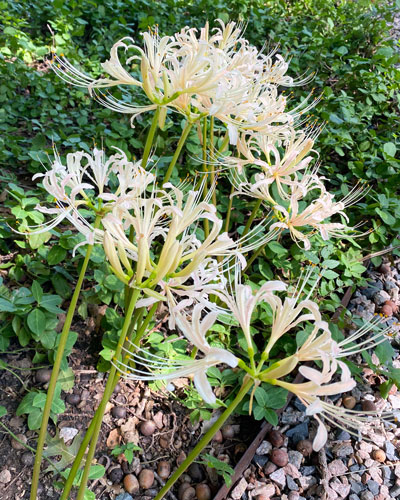Just waiting for a rainstorm
They’re Lycoris albiflora, white-flowering spider lilies. You know their red-blooming sisters far better. But they haven’t started flowering yet. At least not in our gardens. I’ll save them for another time here.

This planting started out as a single bulb 6 or 8 years ago. I planted it along this walk which, in turn, is along our drive. I pass by it several times daily.
My bulb didn’t bloom for its first two or three years (not uncommon for spider lilies after they’ve been transplanted). By then it had actually multiplied into a clump of several bulbs, and when they came into flower I was really happy.

By then I’d lost the label, so I texted my good friend and go-to bulb guy Greg Grant to ask any details he might have to offer. He very politely sent me back everything I’d requested. It wasn’t until two or three days later that I realized that Greg had given me the bulb in the first place. I’m sure he got a chuckle out of my note, and I’ve enjoyed telling the story ever since. Things like this keep me humble. Very humble. You just have to keep a journal, folks.
This whole group of plants, headed up by the red type Lycoris radiata var. variata, goes by several common names…
• Spider lily: because of their wispy, spider-like blooms;
• Hurricane lily: because of their tendency to bloom after hurricanes (or the first good rain of the fall); and
• Surprise lily: because they send up their flowers almost overnight, weeks ahead of their foliage.
Enough from me, however. My friend Dr. Gary Knox, Extension Horticulturist from the University of Florida has written a really good fact sheet on all the species and varieties of this genus. He has some interesting information. Take a look.
